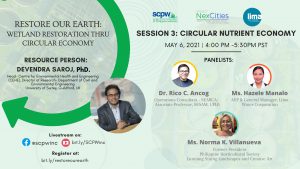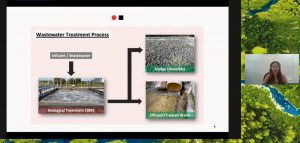The NEXCITIES Project News
Restore our Earth Session 3: Circular Nutrient Economy
 Continuing the celebration of Earth Day 2021, the third and final session for Restore our Earth: Wetland Restoration thru Circular Economy was conducted on May 6, 2021 with Dr. Devendra Saroj and Dr. Michael Promentilla of Project NexCities as resource speakers explaining about circular economy, circular nutrient economy and Project NexCities.
Continuing the celebration of Earth Day 2021, the third and final session for Restore our Earth: Wetland Restoration thru Circular Economy was conducted on May 6, 2021 with Dr. Devendra Saroj and Dr. Michael Promentilla of Project NexCities as resource speakers explaining about circular economy, circular nutrient economy and Project NexCities.
Dr. Saroj’s presentation was on circular economy approach to agriculture where he discussed the value of sewage – and the nutrients found therein- for providing much needed fertilizer to the agriculture sector as it confronts the issue of providing food to the continuously growing population of the world.
The use of sewage is a very sustainable alternative to using chemical fertilizers according to the presentation as the pollutant is diverted from contaminating water bodies , especially in developing countries where there is no proper sewage system. This process will also limit phosphorus mining that can cause environmental
degradation.
Panelists Dr. Rico Ancog from Southeast Asian Regional Center for Graduate Study and Research in Agriculture (SEARCA), Ms. Hazele Manalo of Lima Water, and Ms. Norma K. Villanueva of Philippine Horticultural society were also present at the event to give their insights on the topic.
 Dr. Ancog welcomed the idea of circular nutrient economy as it can benefit many farmers and reduce the biological wastes that flow in our water bodies. He said that projects like NexCities highlights “a very important paradigm shift in the way we do environmental management in the Philippines.”
Dr. Ancog welcomed the idea of circular nutrient economy as it can benefit many farmers and reduce the biological wastes that flow in our water bodies. He said that projects like NexCities highlights “a very important paradigm shift in the way we do environmental management in the Philippines.”
Ms. Hazele Manalo of Lima Water talked about the sewage treatment process at Lima Water and said that they are also considering the use of biosolids as soil conditioner – instead of disposing it in landfill- as they predict that water demand and thus, biosolids will increase in the next five years.
Lima Water and said that they are also considering the use of biosolids as soil conditioner – instead of disposing it in landfill- as they predict that water demand and thus, biosolids will increase in the next five years.
Ms. Manalo said “part of our innovation plan is to look for a more sustainable disposal method that will ultimately harness the value of it as fertilizer or soil conditioner. So while most treat biosolids as waste, there are several potential sectors that will benefit from its energy and nutrient content.”

From the horticultural sector, Ms. Norma K. Villanueva also welcomed the idea of circular nutrient economy even though it is still a novel one and is still in the research stage here in the Philippines. She said that if this technology can help lower the cost in agriculture production, farmers will definitely be more open to try the fertilizer produced from sewage.

Converting wastewater into nutrient-rich fertilizer for a better city of the future
